J
John McIlroy
Guest
Skoda has made its name through great functionality and class-leading practicality. But how will the Czech brand deliver these values in pure-electric vehicles?
The answer is the Skoda Enyaq iV – so it’s time for an in-depth look at the new SUV. We talk to Skoda’s CEO and the firm’s design boss, and meet the people helping to squeeze the car into Skoda’s hometown factory. We visit a UK dealer, too, to see how ready the brand is for potential electric car buyers.
To cap it all, we’ve taken a brand-new Enyaq across the UK – England, Scotland, Wales and Northern Ireland – in just 24 hours, and on a single charge. Read on below and click the links above for everything you need to know about Skoda’s first bespoke electric vehicle.
The Skoda Enyaq iV is available to order in the UK now. Prices start from £31,085 (including the government’s £3,000 plug-in car grant), making the new EV a slightly larger alternative to the Kia e-Niro and Hyundai Kona Electric.
SkodaEnyaq iV 60 Nav is powered by a 62kWh battery pack, which feeds a 178bhp electric motor mounted on the rear axle for a 0-62mph time of 8.7 seconds. More importantly, Skoda claims a maximum range of 256 miles, and when connected to a 50kW DC rapid charger its battery takes on an 80 percent charge in as little as 35 minutes.
The more powerful Skoda Enyaq iV 80 is priced from £35,950 and features an 82kWh battery and a 201bhp electric motor. The upgrades boost the SUV’s claimed maximum range to 333 miles and drop its 0-62mph time to 8.5 seconds, although the larger battery pack means an 80 per cent charge increases to around 40 minutes.
Skoda is on the cusp of one of the biggest changes in the Czech firm’s 125-year history. There’s no doubt that the modern Skoda brand we know today has thrived under VW Group ownership over the past three decades, but just as the industry as a whole is embracing full electrification, it’s a factor Skoda and its relatively new chief executive officer Thomas Schäfer know could be a leveller for the car industry. It’s also one he believes the brand is beautifully poised to capitalise on with its first bespoke electric car, the Enyaq iV.
“The Enyaq for us is definitely a game changer. It unites us all completely behind this future and how we move the company forward,” he says. “It’s a true halo model that combines all the typical values that our customers love: lots of space, many Simply Clever ideas and easy to charge.”
Schäfer took over the top job at Skoda at the start of August 2020, and approaching a year in charge, it’s clear that from the very start the boss had a deep understanding of the brand and the ‘Skodians’ – every member of the Skoda community, from workers in the factories to designers, engineers, dealers and even fans of the Czech marque.
After speaking with Schäfer for just five minutes, it’s obvious he’s a realist but with aspirations for the brand, and a boss who is in touch with Skoda’s clientele. He knows that not all of the firm’s existing and future customers might either know EVs inside out, or be totally receptive to the thought of ditching their petrol or diesel car in favour of an electric model. Yet he has a message to put their minds at rest, putting the customer first in the buying decision and the adoption of electrification.
“We have spent a lot of time on this question – how to understand what the customer is looking for and how we can reassure them to take away their worries about EVs; how to move from a traditional car to an electric one,” he explains. “This journey isn’t always as easy as you might think.
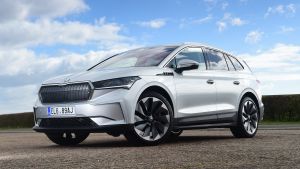
Skoda Enyaq iV 80 - front static
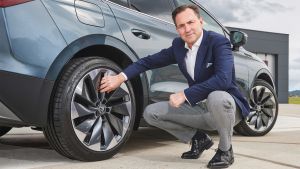
Skoda Enyaq and Thomas Schäfer - wheel
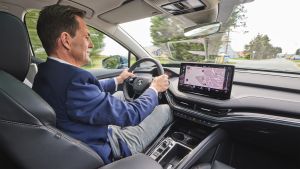
Skoda Enyaq and Thomas Schäfer - driving
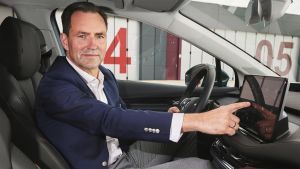
Skoda Enyaq and Thomas Schäfer - interior
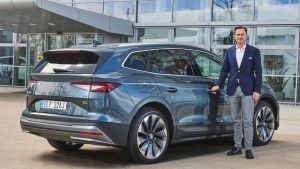
Skoda Enyaq and Thomas Schäfer - rear
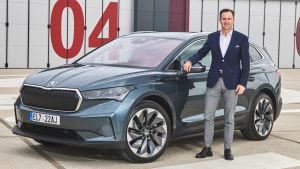
Skoda Enyaq and Thomas Schäfer - front
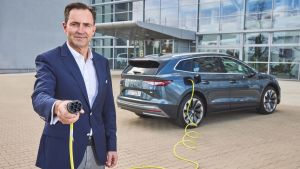
Skoda Enyaq and Thomas Schäfer - rear cable
“But we are prepared for this. We’ve trained our dealers, we’ve trained the organisations, and everybody is aware of what the customers might be struggling with: where’s the next charging station? How far can I go? Where is the charging socket? But ultimately, it’s still a Skoda, offering all of the clever solutions and space that the brand is known for.”
It sounds like marketing schtick, but Schäfer is right. Assess the Enyaq objectively (we have) and you’ll realise that when he says, “We didn’t try to reinvent the car completely and do something different. We carried on with our tradition,” he’s right. It’s evidenced by the fact that you can throw a bike in the back of it, and even tow a trailer with the Enyaq; not many EVs are certified to do so, which gives the iV a genuine point of difference to some other electric family SUVs.
The subject of differentiation could be a thorny topic, given many other VW Group brands such as Volkswagen, Audi and Cupra also use the bespoke MEB platform for EVs that the Enyaq is based on. Look at Skoda’s other combustion-engined and plug-in hybrid offerings based on the MQB platform (which VW, Audi, SEAT and Cupra also use) and the presence of a petrol or diesel engine allows for different calibration; the motor is at the model’s heart and often gives its character. But even by removing this key factor with a car like the Enyaq, Schäfer still doesn’t believe it’s an issue.
“The [MEB] platform is very versatile and gave us plenty of room, we think it’s well differentiated,” Schäfer says. “We’ve had a chance to drive all of the MEB cars, and I would say the differentiation has been delivered perfectly; everything our key customer group appreciates in our cars is present. We made it a Skoda, but electric.”
Naturally, this first step into a brave new world wasn’t without its difficulties. There are risks and challenges for any manufacturer embarking on developing its early EVs, but factoring in the current political situation, the technology involved, the needs of Skoda’s existing customers and the desire to attract new ones, too, it’s a tough act to juggle the required elements of the package. “We obviously started the project when the world wasn’t as it is now,” he says, referring to the Covid-19 pandemic. “However, when it comes to EVs I would say the world has now become a lot more certain over the past 18 months. Look at the European Green Deal, look at various countries announcing how they are going to do things – the big question is how fast?
“For us it’s very important we keep the pace up and match the faster-developing nations when it comes to electromobility – but we also need to serve the customers in nations that aren’t developing as fast when it comes to electric cars.”
It’s here where Schäfer outlines Skoda’s focus on parallel channels when it comes to ICE cars and EVs. He’s a pragmatist who knows that not everyone will want to adopt electrification immediately, and Skoda is still committed to developing combustion-engined cars for as long as is feasibly possible; the new Fabia supermini is launching later this year, while the next-generation Superb has been confirmed, too.
No matter which type of vehicles Skoda develops and regardless of powertrain, they all have to meet the use cases Skoda sets for itself when it comes to how owners in each segment will live with their cars. Yes, EVs are an inevitability, but by launching relatively early with its Enyaq iV family SUV, Skoda is protecting its future in many ways.

Skoda Enyaq iV 80 - front static

Skoda Enyaq and Thomas Schäfer - wheel

Skoda Enyaq and Thomas Schäfer - driving

Skoda Enyaq and Thomas Schäfer - interior

Skoda Enyaq and Thomas Schäfer - rear

Skoda Enyaq and Thomas Schäfer - front

Skoda Enyaq and Thomas Schäfer - rear cable
Schäfer says: “The challenge is how you balance it all. We only have so much money that we can spend, it’s not endless. That’s why we’re not launching a wide range of EVs in the very beginning. So it was clear that the team needed to focus on a car which serves the maximum number of customers.
“That’s what we’ve seen from the first couple of months taking orders. Many have come from outside the brand, but lots are Skodians happily changing from one model to another. We’ve shown something that is really progressive.”
Of course, while Skoda has a diverse product portfolio now, in a decade’s time it will look significantly different, and with a focus on EVs in the future, the brand has to secure that now when it comes to factors such as production and supply. As a result, a battery factory in its home country could be pivotal in ensuring Skoda’s electric future is assured. Schäfer knows as much when we talk about his confidence in reaching a deal for one of the VW Group’s planned battery production centres to be located within the Czech Republic.
“To ensure that both Skoda and the country emerge stronger from the radical transformation process,” he says, adopting a polite phrase to describe the EV revolution, “we are convinced that the Czech Republic must evolve into an electromobility hub.”
A Czech gigafactory would be hugely relevant to the brand and its home market, but it also potentially have a positive bearing on the price of Skoda’s future EV models and its production capability; the Enyaq is the only European-made MEB model to be built outside of the Zwickau plant in Germany, assembled at Skoda’s plant at Mladá Boleslav.
Electrification opens the firm up to a more emotional offering, too. Up to now, apart from the vRS sub-brand, it has always stood for practicality and pragmatism in the modern era, but while Skoda isn’t deserting its heartland, new vehicle architectures allow it to add new elements in the future, too.
“You can have emotional elements in your design, and we’re working on that, but this first decade of electrification will have a tremendous financial demand,” Schäfer explains. “But I would say good design doesn’t have to be expensive and that’s what I think the team has done with the Enyaq. This is a car with an outstanding design and with the Coupé iV version and vRS derivatives, there is still plenty to come.
“I think the design language will evolve, and with electric cars you are a little bit freer to play on the design side – and clearly the majority of our attention will now go into electric cars. It has to.”

Skoda Enyaq iV 80 - front static

Skoda Enyaq and Thomas Schäfer - wheel

Skoda Enyaq and Thomas Schäfer - driving

Skoda Enyaq and Thomas Schäfer - interior

Skoda Enyaq and Thomas Schäfer - rear

Skoda Enyaq and Thomas Schäfer - front

Skoda Enyaq and Thomas Schäfer - rear cable
Schäfer touches upon one of Skoda’s key strengths with vRS, and it’s something that can be exploited even more widely in the future. The instant performance associated with electric motors goes hand-in-glove with the vRS range. With no loss of practicality, electrification can provide big performance, delivering greater thrills for keener drivers without compromising the elements Skoda prides itself on.
“The vRS is emotional Skoda,” Schäfer believes. “You get a lot of performance and good looks for a very small price compared with what else is in the competitor space. On the electric side it could play out like this. When they first showed me the Enyaq vRS and the Enyaq Coupé I thought, ‘Oh wow’. vRS is a halo that helps us attract customers from other fields. With high horsepower, its more sporty feeling, and the look and drivability, the car is in the right direction for a brand like Skoda. We don’t do something that is not connected to our roots, but we’ll do a little more with vRS as an electric proposition in the future.”
Enyaq is the present, but Schäfer has already admitted that Skoda is working on a smaller EV to broaden the range. Likely to be a compact SUV, it’s under development, with the case for this model – and potentially more even smaller EVs – strengthened by customer reaction to Skoda’s first bespoke EV. This reinforces how the Enyaq will inform the brand’s future electric range and therefore why it’s so important.
On the subject of small EVs, Schäfer says that for a small electric car costing less than 20,000 Euros, “I would say between 350 and 400km [217 to 248 miles] is probably a reasonable range, because you don’t really need anything more than that. It’s this dance between cost and range.”
This will define the next decade, not just for Skoda’s offerings, but the VW Group and the industry as a whole. Schäfer believes the novelty of electric mobility is currently pushing everyone into a “bigger, faster and further” mentality, where consumers forget what they really need in a vehicle the size of a normal family model, maybe one size below the Enyaq. But it’s all part of adopting an electric future and getting used to owning, using and living with a car in a different way. Ask yourself this: even before the Covid-19 pandemic, when was the last time you drove more than 200 miles in a day? The majority of people might be surprised at the relatively small distance that they travel on any given day.
An average of 10,000 miles per year (significantly higher than the UK annual average) equates to just over 27 miles travelled per day; even if it doesn’t quite work out like this in real life, it shows that EVs can work for many people if they have the set-up to make the most of them.
The way we buy and own cars will change, too, so Skoda’s approach must also move with the times. Covid has accelerated this, with digital sales and the virtual showroom coming to the fore, but “these things were embraced and even topics like mobility subscription models – stuff that was niche a while ago – have all of a sudden become pretty interesting,” according to Schäfer. The brand is already trying to simplify how a vehicle is configured. Schäfer says: “It’s a myth to believe that you need 10,000 different choices for a car the size of an Octavia. Just package it properly.”
The Enyaq is showing the way on many fronts, then. Its development and release have been a voyage of discovery for Skoda, but the brand has learnt quickly – and the early signs are that it has the right car for the task at hand.
What does the Skoda Enyaq have to beat? Czech out our list of the best electric cars on sale now…
Continue reading...
The answer is the Skoda Enyaq iV – so it’s time for an in-depth look at the new SUV. We talk to Skoda’s CEO and the firm’s design boss, and meet the people helping to squeeze the car into Skoda’s hometown factory. We visit a UK dealer, too, to see how ready the brand is for potential electric car buyers.
To cap it all, we’ve taken a brand-new Enyaq across the UK – England, Scotland, Wales and Northern Ireland – in just 24 hours, and on a single charge. Read on below and click the links above for everything you need to know about Skoda’s first bespoke electric vehicle.
About the Skoda Enyaq
The Skoda Enyaq iV is available to order in the UK now. Prices start from £31,085 (including the government’s £3,000 plug-in car grant), making the new EV a slightly larger alternative to the Kia e-Niro and Hyundai Kona Electric.
SkodaEnyaq iV 60 Nav is powered by a 62kWh battery pack, which feeds a 178bhp electric motor mounted on the rear axle for a 0-62mph time of 8.7 seconds. More importantly, Skoda claims a maximum range of 256 miles, and when connected to a 50kW DC rapid charger its battery takes on an 80 percent charge in as little as 35 minutes.
- SEE MORE Best electric cars to buy 2021
The more powerful Skoda Enyaq iV 80 is priced from £35,950 and features an 82kWh battery and a 201bhp electric motor. The upgrades boost the SUV’s claimed maximum range to 333 miles and drop its 0-62mph time to 8.5 seconds, although the larger battery pack means an 80 per cent charge increases to around 40 minutes.
Skoda's EV future: CEO talks Enyaq and more
Skoda is on the cusp of one of the biggest changes in the Czech firm’s 125-year history. There’s no doubt that the modern Skoda brand we know today has thrived under VW Group ownership over the past three decades, but just as the industry as a whole is embracing full electrification, it’s a factor Skoda and its relatively new chief executive officer Thomas Schäfer know could be a leveller for the car industry. It’s also one he believes the brand is beautifully poised to capitalise on with its first bespoke electric car, the Enyaq iV.
“The Enyaq for us is definitely a game changer. It unites us all completely behind this future and how we move the company forward,” he says. “It’s a true halo model that combines all the typical values that our customers love: lots of space, many Simply Clever ideas and easy to charge.”
- SEE MORE New Skoda Enyaq iV 2021 review
Schäfer took over the top job at Skoda at the start of August 2020, and approaching a year in charge, it’s clear that from the very start the boss had a deep understanding of the brand and the ‘Skodians’ – every member of the Skoda community, from workers in the factories to designers, engineers, dealers and even fans of the Czech marque.
After speaking with Schäfer for just five minutes, it’s obvious he’s a realist but with aspirations for the brand, and a boss who is in touch with Skoda’s clientele. He knows that not all of the firm’s existing and future customers might either know EVs inside out, or be totally receptive to the thought of ditching their petrol or diesel car in favour of an electric model. Yet he has a message to put their minds at rest, putting the customer first in the buying decision and the adoption of electrification.
“We have spent a lot of time on this question – how to understand what the customer is looking for and how we can reassure them to take away their worries about EVs; how to move from a traditional car to an electric one,” he explains. “This journey isn’t always as easy as you might think.

Skoda Enyaq iV 80 - front static

Skoda Enyaq and Thomas Schäfer - wheel

Skoda Enyaq and Thomas Schäfer - driving

Skoda Enyaq and Thomas Schäfer - interior

Skoda Enyaq and Thomas Schäfer - rear

Skoda Enyaq and Thomas Schäfer - front

Skoda Enyaq and Thomas Schäfer - rear cable
“But we are prepared for this. We’ve trained our dealers, we’ve trained the organisations, and everybody is aware of what the customers might be struggling with: where’s the next charging station? How far can I go? Where is the charging socket? But ultimately, it’s still a Skoda, offering all of the clever solutions and space that the brand is known for.”
It sounds like marketing schtick, but Schäfer is right. Assess the Enyaq objectively (we have) and you’ll realise that when he says, “We didn’t try to reinvent the car completely and do something different. We carried on with our tradition,” he’s right. It’s evidenced by the fact that you can throw a bike in the back of it, and even tow a trailer with the Enyaq; not many EVs are certified to do so, which gives the iV a genuine point of difference to some other electric family SUVs.
The subject of differentiation could be a thorny topic, given many other VW Group brands such as Volkswagen, Audi and Cupra also use the bespoke MEB platform for EVs that the Enyaq is based on. Look at Skoda’s other combustion-engined and plug-in hybrid offerings based on the MQB platform (which VW, Audi, SEAT and Cupra also use) and the presence of a petrol or diesel engine allows for different calibration; the motor is at the model’s heart and often gives its character. But even by removing this key factor with a car like the Enyaq, Schäfer still doesn’t believe it’s an issue.
“The [MEB] platform is very versatile and gave us plenty of room, we think it’s well differentiated,” Schäfer says. “We’ve had a chance to drive all of the MEB cars, and I would say the differentiation has been delivered perfectly; everything our key customer group appreciates in our cars is present. We made it a Skoda, but electric.”
Naturally, this first step into a brave new world wasn’t without its difficulties. There are risks and challenges for any manufacturer embarking on developing its early EVs, but factoring in the current political situation, the technology involved, the needs of Skoda’s existing customers and the desire to attract new ones, too, it’s a tough act to juggle the required elements of the package. “We obviously started the project when the world wasn’t as it is now,” he says, referring to the Covid-19 pandemic. “However, when it comes to EVs I would say the world has now become a lot more certain over the past 18 months. Look at the European Green Deal, look at various countries announcing how they are going to do things – the big question is how fast?
“For us it’s very important we keep the pace up and match the faster-developing nations when it comes to electromobility – but we also need to serve the customers in nations that aren’t developing as fast when it comes to electric cars.”
It’s here where Schäfer outlines Skoda’s focus on parallel channels when it comes to ICE cars and EVs. He’s a pragmatist who knows that not everyone will want to adopt electrification immediately, and Skoda is still committed to developing combustion-engined cars for as long as is feasibly possible; the new Fabia supermini is launching later this year, while the next-generation Superb has been confirmed, too.
No matter which type of vehicles Skoda develops and regardless of powertrain, they all have to meet the use cases Skoda sets for itself when it comes to how owners in each segment will live with their cars. Yes, EVs are an inevitability, but by launching relatively early with its Enyaq iV family SUV, Skoda is protecting its future in many ways.

Skoda Enyaq iV 80 - front static

Skoda Enyaq and Thomas Schäfer - wheel

Skoda Enyaq and Thomas Schäfer - driving

Skoda Enyaq and Thomas Schäfer - interior

Skoda Enyaq and Thomas Schäfer - rear

Skoda Enyaq and Thomas Schäfer - front

Skoda Enyaq and Thomas Schäfer - rear cable
Schäfer says: “The challenge is how you balance it all. We only have so much money that we can spend, it’s not endless. That’s why we’re not launching a wide range of EVs in the very beginning. So it was clear that the team needed to focus on a car which serves the maximum number of customers.
“That’s what we’ve seen from the first couple of months taking orders. Many have come from outside the brand, but lots are Skodians happily changing from one model to another. We’ve shown something that is really progressive.”
Of course, while Skoda has a diverse product portfolio now, in a decade’s time it will look significantly different, and with a focus on EVs in the future, the brand has to secure that now when it comes to factors such as production and supply. As a result, a battery factory in its home country could be pivotal in ensuring Skoda’s electric future is assured. Schäfer knows as much when we talk about his confidence in reaching a deal for one of the VW Group’s planned battery production centres to be located within the Czech Republic.
“To ensure that both Skoda and the country emerge stronger from the radical transformation process,” he says, adopting a polite phrase to describe the EV revolution, “we are convinced that the Czech Republic must evolve into an electromobility hub.”
A Czech gigafactory would be hugely relevant to the brand and its home market, but it also potentially have a positive bearing on the price of Skoda’s future EV models and its production capability; the Enyaq is the only European-made MEB model to be built outside of the Zwickau plant in Germany, assembled at Skoda’s plant at Mladá Boleslav.
Electrification opens the firm up to a more emotional offering, too. Up to now, apart from the vRS sub-brand, it has always stood for practicality and pragmatism in the modern era, but while Skoda isn’t deserting its heartland, new vehicle architectures allow it to add new elements in the future, too.
“You can have emotional elements in your design, and we’re working on that, but this first decade of electrification will have a tremendous financial demand,” Schäfer explains. “But I would say good design doesn’t have to be expensive and that’s what I think the team has done with the Enyaq. This is a car with an outstanding design and with the Coupé iV version and vRS derivatives, there is still plenty to come.
“I think the design language will evolve, and with electric cars you are a little bit freer to play on the design side – and clearly the majority of our attention will now go into electric cars. It has to.”

Skoda Enyaq iV 80 - front static

Skoda Enyaq and Thomas Schäfer - wheel

Skoda Enyaq and Thomas Schäfer - driving

Skoda Enyaq and Thomas Schäfer - interior

Skoda Enyaq and Thomas Schäfer - rear

Skoda Enyaq and Thomas Schäfer - front

Skoda Enyaq and Thomas Schäfer - rear cable
Schäfer touches upon one of Skoda’s key strengths with vRS, and it’s something that can be exploited even more widely in the future. The instant performance associated with electric motors goes hand-in-glove with the vRS range. With no loss of practicality, electrification can provide big performance, delivering greater thrills for keener drivers without compromising the elements Skoda prides itself on.
“The vRS is emotional Skoda,” Schäfer believes. “You get a lot of performance and good looks for a very small price compared with what else is in the competitor space. On the electric side it could play out like this. When they first showed me the Enyaq vRS and the Enyaq Coupé I thought, ‘Oh wow’. vRS is a halo that helps us attract customers from other fields. With high horsepower, its more sporty feeling, and the look and drivability, the car is in the right direction for a brand like Skoda. We don’t do something that is not connected to our roots, but we’ll do a little more with vRS as an electric proposition in the future.”
Enyaq is the present, but Schäfer has already admitted that Skoda is working on a smaller EV to broaden the range. Likely to be a compact SUV, it’s under development, with the case for this model – and potentially more even smaller EVs – strengthened by customer reaction to Skoda’s first bespoke EV. This reinforces how the Enyaq will inform the brand’s future electric range and therefore why it’s so important.
On the subject of small EVs, Schäfer says that for a small electric car costing less than 20,000 Euros, “I would say between 350 and 400km [217 to 248 miles] is probably a reasonable range, because you don’t really need anything more than that. It’s this dance between cost and range.”
This will define the next decade, not just for Skoda’s offerings, but the VW Group and the industry as a whole. Schäfer believes the novelty of electric mobility is currently pushing everyone into a “bigger, faster and further” mentality, where consumers forget what they really need in a vehicle the size of a normal family model, maybe one size below the Enyaq. But it’s all part of adopting an electric future and getting used to owning, using and living with a car in a different way. Ask yourself this: even before the Covid-19 pandemic, when was the last time you drove more than 200 miles in a day? The majority of people might be surprised at the relatively small distance that they travel on any given day.
An average of 10,000 miles per year (significantly higher than the UK annual average) equates to just over 27 miles travelled per day; even if it doesn’t quite work out like this in real life, it shows that EVs can work for many people if they have the set-up to make the most of them.
The way we buy and own cars will change, too, so Skoda’s approach must also move with the times. Covid has accelerated this, with digital sales and the virtual showroom coming to the fore, but “these things were embraced and even topics like mobility subscription models – stuff that was niche a while ago – have all of a sudden become pretty interesting,” according to Schäfer. The brand is already trying to simplify how a vehicle is configured. Schäfer says: “It’s a myth to believe that you need 10,000 different choices for a car the size of an Octavia. Just package it properly.”
The Enyaq is showing the way on many fronts, then. Its development and release have been a voyage of discovery for Skoda, but the brand has learnt quickly – and the early signs are that it has the right car for the task at hand.
What does the Skoda Enyaq have to beat? Czech out our list of the best electric cars on sale now…
Continue reading...
